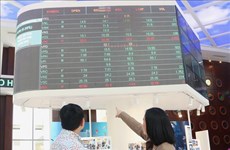Vietnamese pepper sees increasing status on global market
Pepper is an interesting exception among Vietnam’s export farming goods,
as it has maintained a high export value for eight consecutive years,
especially in the past three years, the Nhan Dan (People) online
newspaper reported.
Pepper is an interesting exception among Vietnam’s export farming goods,
as it has maintained a high export value for eight consecutive years,
especially in the past three years, the Nhan Dan (People) online
newspaper reported.
Accounting for 30 percent in volume and over 50 percent of the global market share, Vietnamese pepper has been affirming its prestigious status around the world step by step, as other countries begin looking to Vietnam’s pepper selling price as a reference point.
The International Pepper Community (IPC) has recently proposed to move its headquarters from Indonesia, previously the largest pepper producer, to Vietnam.
Vietnam shipped abroad 92,000 tonnes of pepper in the first five months of this year, earning 645 million USD in export revenue. This represents a fantastic upward growth of 33.6 percent in volume and 42.3 percent in value.
According to the Vietnam Pepper Association (VPA), if these figures remain steady for the rest of the year, Vietnam’s pepper exports in 2014 are likely to reach about 125,000–130,000 tonnes and bring in record revenue of 1 billion USD. The prospect of joining the group of 1 billion USD export earners was an unthought-of dream for Vietnam’s pepper industry 10 years ago.
It is the VPA’s belief that Vietnam’s pepper products will definitely be able to regulate the pepper price on the world market provided there is further consensus between enterprises and pepper farmers. Pepper is not Vietnam’s only agricultural item with overwhelming outputs and trade, but it is the country’s first industry to gradually establish its role and impact on the international trade market.
The 2011–2014 period could be seen as the best stage in the developmental history of Vietnamese pepper. According to the IPC’s forecast, Vietnamese pepper possesses great potential and many competitive advantages, in terms of both volume and price, against Indonesia and Brazil, the largest pepper exporters prior to Vietnam’s emergence.
IPC Executive Director S. Kannan has stated that Vietnam remains the world’s largest pepper producer and exporter under any circumstances. While global economic and financial recession has adversely impacted enterprises in exporting farming products over the past three or four years, the pepper industry has maintained its robust growth, with many records established year after year in export volume, revenue and selling prices.
The role and status of Vietnamese pepper have been increasingly strengthened in the world market as the international pepper community looks to Vietnam with respect, understanding and sharing.
During the 1990s, Singapore had taken its advantages in the world pepper trade with a large import volume of up to 44,000 tonnes per year, half of which was supplied by Indonesia. However, the figure later fell sharply to just 10,000 tonnes in 2010, which according to the VPA, was attributed to the fact that importers began purchasing pepper items directly from producing countries, including Vietnam.
At present, Asia accounts for 36 percent of Vietnamese pepper’s total export market share, followed by Europe, the Americas and Africa with 34, 20 and 10 percent, respectively. Singapore’s pepper imports have rebounded recently, reaching 20,200 tonnes in 2013, with its major supply source turning from Indonesia (28 percent of total import volume) to Vietnam (60 percent).
The world’s previous largest pepper producers and exporters, Brazil and Indonesia, have been accelerating cooperation with Vietnam in pepper import and export, with total pepper trading volume up to tens of thousands of tonnes each year.
From mainly exporting black pepper, Vietnam now also ships white and powder pepper to European, Middle Eastern and North American nations, adding more value to pepper products and bringing in greater profits.
Thanks to Vietnamese pepper’s increasing status and influence on the global market, IPC Executive Director Kannan has also officially proposed to move the IPC headquarter from Indonesia to Vietnam.-VNA
Accounting for 30 percent in volume and over 50 percent of the global market share, Vietnamese pepper has been affirming its prestigious status around the world step by step, as other countries begin looking to Vietnam’s pepper selling price as a reference point.
The International Pepper Community (IPC) has recently proposed to move its headquarters from Indonesia, previously the largest pepper producer, to Vietnam.
Vietnam shipped abroad 92,000 tonnes of pepper in the first five months of this year, earning 645 million USD in export revenue. This represents a fantastic upward growth of 33.6 percent in volume and 42.3 percent in value.
According to the Vietnam Pepper Association (VPA), if these figures remain steady for the rest of the year, Vietnam’s pepper exports in 2014 are likely to reach about 125,000–130,000 tonnes and bring in record revenue of 1 billion USD. The prospect of joining the group of 1 billion USD export earners was an unthought-of dream for Vietnam’s pepper industry 10 years ago.
It is the VPA’s belief that Vietnam’s pepper products will definitely be able to regulate the pepper price on the world market provided there is further consensus between enterprises and pepper farmers. Pepper is not Vietnam’s only agricultural item with overwhelming outputs and trade, but it is the country’s first industry to gradually establish its role and impact on the international trade market.
The 2011–2014 period could be seen as the best stage in the developmental history of Vietnamese pepper. According to the IPC’s forecast, Vietnamese pepper possesses great potential and many competitive advantages, in terms of both volume and price, against Indonesia and Brazil, the largest pepper exporters prior to Vietnam’s emergence.
IPC Executive Director S. Kannan has stated that Vietnam remains the world’s largest pepper producer and exporter under any circumstances. While global economic and financial recession has adversely impacted enterprises in exporting farming products over the past three or four years, the pepper industry has maintained its robust growth, with many records established year after year in export volume, revenue and selling prices.
The role and status of Vietnamese pepper have been increasingly strengthened in the world market as the international pepper community looks to Vietnam with respect, understanding and sharing.
During the 1990s, Singapore had taken its advantages in the world pepper trade with a large import volume of up to 44,000 tonnes per year, half of which was supplied by Indonesia. However, the figure later fell sharply to just 10,000 tonnes in 2010, which according to the VPA, was attributed to the fact that importers began purchasing pepper items directly from producing countries, including Vietnam.
At present, Asia accounts for 36 percent of Vietnamese pepper’s total export market share, followed by Europe, the Americas and Africa with 34, 20 and 10 percent, respectively. Singapore’s pepper imports have rebounded recently, reaching 20,200 tonnes in 2013, with its major supply source turning from Indonesia (28 percent of total import volume) to Vietnam (60 percent).
The world’s previous largest pepper producers and exporters, Brazil and Indonesia, have been accelerating cooperation with Vietnam in pepper import and export, with total pepper trading volume up to tens of thousands of tonnes each year.
From mainly exporting black pepper, Vietnam now also ships white and powder pepper to European, Middle Eastern and North American nations, adding more value to pepper products and bringing in greater profits.
Thanks to Vietnamese pepper’s increasing status and influence on the global market, IPC Executive Director Kannan has also officially proposed to move the IPC headquarter from Indonesia to Vietnam.-VNA













